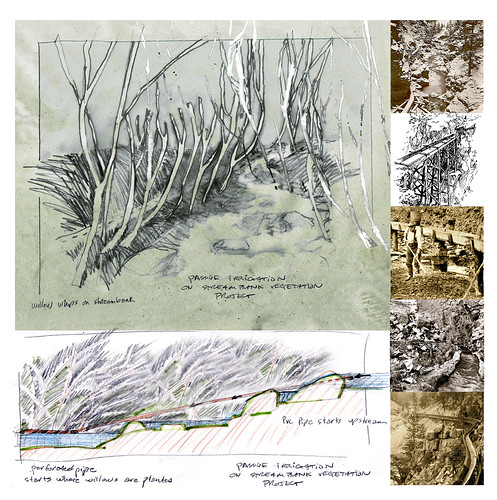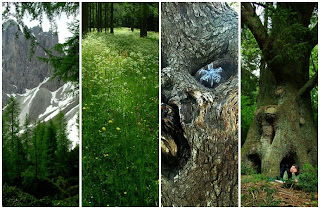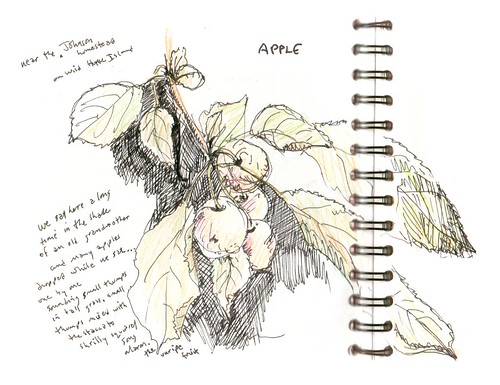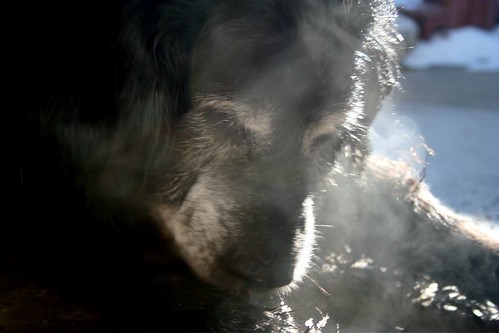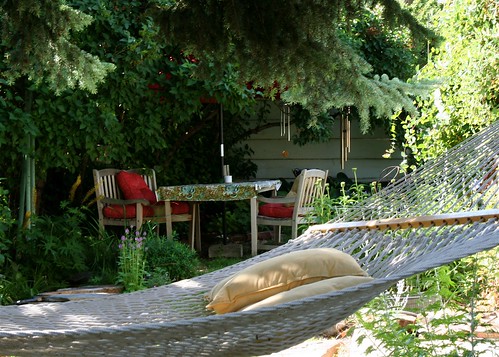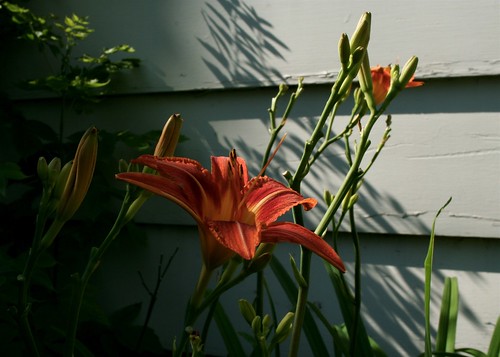Monday, December 24
Saturday, December 22
Solstice: Celebrate Winter in Montana
I wish all of my blog readers happiness and clarity of heart in the coming year -- may you each have the blessing of Good Luck in your lives.
To celebrate winter, to honor Mother Earth, and to welcome the light coming back to us from the darkest, longest night of the year ... I would like to share with you a selection of winter images from my Montana albums.
Click on a thumbnail to view the image larger. To see the original (much larger) photo, click LINK below the photo on the right. Enjoy!
Tuesday, November 27
Wild Geese (after Mary Oliver)
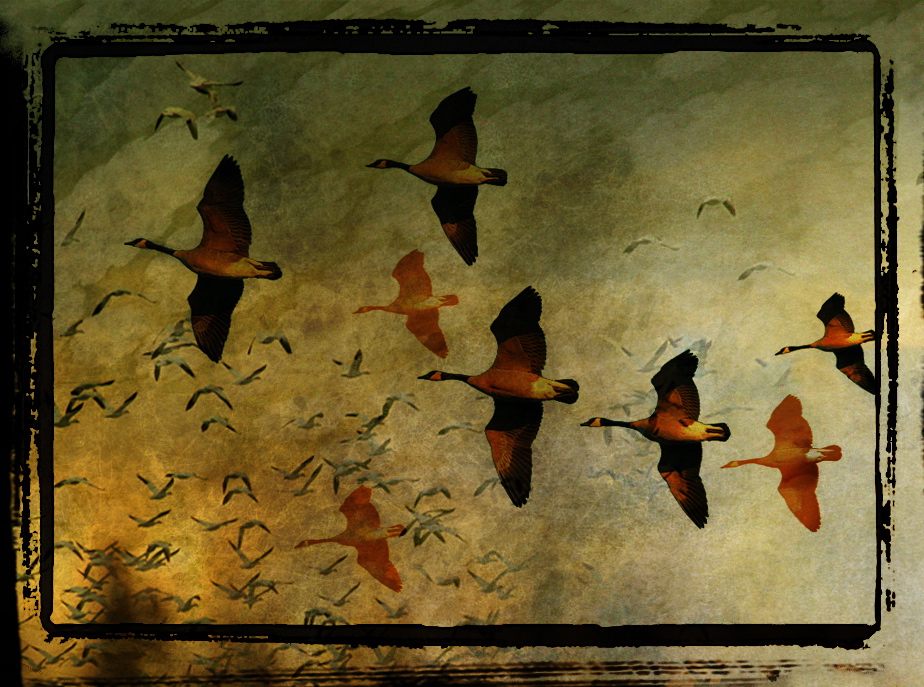
Copyright© 2007 by Maureen Shaughnessy
I have posted the poem, Wild Geese before, on Raven's Nest and Land of Little Rain. It's worth posting again (and again.) Everytime I read this poem, I come at it from a different angle, as a different person.
Wild Geese
You do not have to be good.
You do not have to walk on your knees
for a hundred miles through the desert, repenting.
You only have to let the soft animal of your body
love what it loves.
Tell me about despair, yours, and I will tell you mine.
Meanwhile the world goes on.
Meanwhile the sun and the clear pebbles of the rain
are moving across the landscapes,
over the prairies and the deep trees,
the mountains and the rivers.
Meanwhile the wild geese, high in the clean blue air,
are heading home again.
Whoever you are, no matter how lonely,
the world offers itself to your imagination,
calls to you like the wild geese, harsh and exciting--
over and over announcing your place
in the family of things.
-- © by Mary Oliver.
Oliver's latest collection of poems, Our World, is a collaboration between Mary and her late partner, Molly Malone Cook, who made the photographs accompanying the poems. Molly died in 2005.
Another exquisite book of Oliver's poems, Thirst, touches her experiences with grief and spiritual growth after Molly's death. I read these poems often -- Mary Oliver's sense of faith and connection have helped me personally through times of great sorrow.
I made the digital painting above, using my own images and two from Liz Saunders, of Alberta.
Saturday, September 8
Irrigating newly planted willows along creekbed
At a creekside cabin out in the mountains, we want more privacy from the road. A creek flows between the cabin and the road (see photo and description below) We have planted willow whips on the road-side of the creek by cutting wands (or whips) from the existing willows, dipping the ends in rooting hormone (which, ironically, comes from willow) and sticking these in the embankment. To encourage the willows to fill in as fast as possible, we will need to irrigate them during the dry season. Short of installing an automatic irrigation system, we are hoping to install a pipe flume or sluice to bring the water to the willows passively.

Looking upstream in early spring. The road is above the creek, just off the upper left of the photo. It's pretty easy to see the creek and cabin (off the photo on the right) from the road.
Flumes have been used historically to carry water from a natural watercourse to some distance away, without the use of a pump. Flumes were often used in combination with a race or pipe to convey water to mills, mines and agricultural fields.
A flume carries the water at an elevated level above ground. Historically flumes were built of wood, sometimes lined with metal, and mounted on a scaffold to carry the water crosswise along a slope, or mounted on a trestle to convey the water across a depression such as a stream bed or river bed. Pipes could also be used in the same manner, to carry water above ground to where it was needed.
A race is an open channel for conveying water. It can be a simple earth ditch, or it can be lined with timber, metal, concrete or stone. A race or flume system would always start on a watercourse at a location upstream from where the water was needed, either for a gristmill, sawmill, farm fields, waterwheel/water turbine, or a mining operation.
Both a race and a flume would run almost level with just a slight downhill pitch, to carry water to somewhere the stream didn't naturally go. The more gradual the pitch of the race or flume, the farther the water could be carried without using a pump. Historically, a race and/or flume system would range from a short ditch to a water supply channel many miles long, linked to supply water courses and storage dams. If there was a gulch, canyon or other declivity along the course of the race, a flume would be built on a trestle, to maintain a constant fall.
We will need to work out some kinks in the plans, but I like the idea of using old-fashioned methods to create a low-tech solution to challenges like this one. Depending on when we put this idea to use, I'll post updates here at Raven's Nest.
Saturday, September 1
Festival of Trees #15: a Collector's Delight
Welcome to the Festival of the Trees #15.
Thank you everyone for sending those links and articles. I received scads of excellent contributions - enough to make a large collection that should have something for everyone. So, let's jump right in:

Anyone who has been around the Festival of Trees for awhile will recognize Daniel Mosquin, head poobah at the University of British Columbia's Botany Photo of the Day. That's one of Daniel's beautiful photos, above, a Mimosa monancistra. Daniel constantly delights me with his beautiful photos taken in the botanical gardens as well as on his travels. I can't imagine hosting a FOTT without giving Daniel a plug. So thanks, Daniel for all the time and effort you put into BPOTD. His site also features work by other photogs, especially by members of the BPOTD flickr group. Daniel also includes with every day's photo, either a link to a photographic website or to a botany web link. Always educational ... often hugely entertaining.

Woodworker Tim Carney, shares some fascinating stuff about Baobab trees at his blog, Shop Talk. The photo, above, is by Daniel Montesinos.
The Clarity of Night: Entry #56 (a short story with trees and forests in its heart. Written by Helen Flatley, posted and hosted by Jason Evans of The Clarity of Night blog.) The Clarity of Night: Entry #49 (Another tree-story from the Halo contest) and The Clarity of Night: Entry #12 (Another contest entry - this one more poetry than prose, and also speaking to the trees.)
Nature is an Art Gallery (the photo, left, is just one of many) comes to us via Gerry Gomez Pearlberg at Global Swarming Honeybees (she has lots of info on bees, too) "Dawn: a glorious caterpillar descends from a tree, with twinkling trees in the background ..."
Stuart Forsyth, of The Thought Menagerie, was in a frustrated mood one day so he decided to head outside and shoot some tree photos. 
Stuart writes, "there is nothing like doing something you love to change your mood and feelings." A second contribution from Stuart, along with more awesome pics like this cork tree, is A Walk in the Park.
Wren, of the illustrious and beautiful blog, Wrenaissance Reflections always seems to have something there to entertain and educate us. Check out her recent Wrendition on trees, Treelimma, in which this bird-lover and tree-lover explores her ambiguity about keeping (or not) the mature Bradford Pears in her garden.
I know Wren thinks alot about creating habitat for birds on her property. How many of you take birds and other wildlife into consideration when planning your garden or landscape? There are so many conservation and ecology programs that encourage us to plant more trees or preserve existing trees and to make our home landscapes more inviting to a diversity of plants and animals. It's hard to know where to start pointing out the good ones! Mary Jo Manzanares of The Seattle Traveler, presents Backyard Sanctuary Program Helps Keep Washington one of the Best Places to Live.
Bat Cave, Swamp Style comes to the Festival courtesy of Swamp Things blog. Check out the gorgeous bald cypress (above) posted with that article! I have always loved the "knees" of the bald cypress for their resemblance to elderly folks, gnomes and little people.
_Wollemia_1.jpg)
"Wollemia nobilis" © Ontario Wanderer
Dean Gugler is one of the contributors at Whorled Leaves, an online reading group on nature books. Dean shared his interest in their current book, "The Tree" by Colin tudge, by elaborating on the natural history of the rare Wollemia ""Pine: Wollemia nobilis. Dean relates,
"Although we have found the book fairly heavy for summer reading it has sparked interest in trees in general."

photo ©Fleur-Ange Lamothe
Dean's partner, Fleur-Ange Lamothe is a painter/photographer artist in her own right (that's her photo, just above.) I introduced my friend Fleur-Ange in this blog post with some of my favorite tree photos of hers.
Our very own Dave Bonta, coordinator of the Festival of Trees and blogger at Via Negativa, shares a wonderful post titled, New Life from and Old Chestnut (that's his beautiful photo, left.) Dave also writes, along with another submission on Giant Trees, that "Most Americans would probably be shocked to hear that their redwoods and sequoias aren't quite the largest trees in the world."
I love the way Jarrett writes at his blog, Creature of the Shade. This time Jarrett sent us Southern Flora, Northern Word where he muses on the names of Australian trees. "However acclimated I become, I'll probably never shake the first impression that Australian plants and animals seem designed to mislead the northerner. Anything remotely conifer-like is called a pine. (And the) eucalypts were called ash, boxwood, and even apple."
We have a new Tree-Festivalee, Larry, from Wandering Around Kansas. Welcome, Larry! His contribution is an excellent photo, The Shade Tree. It's still summer in the northern hemisphere (just barely) and, well -- if it's hot where you live, I expect you're still appreciating the shade under trees like the oak in Larry's photo.
American Forests, a conservation group that has been protecting forests and their denizens for over 20 years, has a page of e-cards you can send to friends. Check out their postcards of "champion trees" like the ancient white pine, above. Then head over to their Historic Tree Nursery and dream of planting a piece of history near your own home.
Silver Valley Girl presents Still Life of My Tree posted at Silver Valley Stories. Her post illustrates a great idea: to document one tree you really care about, through the seasons. Still Life of My Tree shows views of the same tri-color beech through seven months so far. The photo, left, shows her beech in July.
Karen Bastille sent in one of my favorite submissions this month, Nurturing The Bond Between Child And Tree. Karen wrote on her blog, At Home With Grandmother Wren, that "we can encourage our children’s relationship with trees and the natural world around them while at the same time renewing our own awareness of its blessings."
Karen includes links for more ideas for teaching children about nature, and ideas she used with her granddaughter who has grown to love the nectarine tree her Grampy planted when she was born.
Finally, I'd like to point you to two more collections on Raven's Nest. This Festival#15 post was getting way too long, but I couldn't bear to leave out a few of my favorite sites about trees in art and literature. If you have the time, I think these two Festival-specific blog posts will be entertaining and elucidating. I apologize for any overlap between these posts and the links above.
Well, folks, that concludes September's edition of Festival of the Trees. The next edition of the Festival will appear at trees, if you please. Send your tree-related submissions to festival (dot) trees (at) gmail (dot) com no later than September 28th. Or if you wish, you can submit your blog article to the next edition of Festival of the Trees using our handy-dandy carnival submission form. Past posts and future hosts can be found on our blog carnival index page.
Thank you to everyone who participated in Festival#15
your host, Maureen Shaughnessy
Introducing Painter Photographer, Fleur-Ange Lamothe
"Every time I meet a tree, if I am truly awake, I stand in awe before it. I listen to its voice, a silent sermon moving me to the depths, touching my heart, and stirring up within my soul a yearning to give my all." - Mary Webb, 1917The above quote comes to me through Fleur-Ange Lamothe, a Canadian artist who blends photography and painting to create visionary art. Lamothe used Mary Webb's words as the sole description for one of her elegant photos of trees. Yet the quote could as well describe Fleur-Ange's entire approach to life and to communicating her vision of Nature into powerful, transformative art.
Fleur-Ange's art is part performance, part canvas or film and part installation; she is all about communication and connection; counterpoint and balance; birth, death and rebirth. She translates her fertile psyche's impulses and emotions into works of tangible beauty that challenge her viewers to look (and feel) under the surface of things.

All photos © Fleur-Ange Lamothe 2007
I have been a "follower" of Fleur-Ange Lamothe on Flickr for the last couple of years. Recently she pulled all of the photos of hers that I had "faved" into one collection called MR's Favorites. It is an understatement to say I was captivated by the slideshow of that set ... watching a fluid river of incredible beauty float and dissolve on my computer monitor. The slideshow is so worth watching -- with 66 photos playing 4 seconds each it takes only four and a half minutes to watch (unless, like me, you keep pausing the show to drink in the beauty every frame or so.)
Whenever I spend enough time to really look deeply at a piece by Fleur-Ange, I get the sense that I am on a journey with an old soul, with someone who has an inborn sense of connection to all of life, who sees even the stones as living beings. I get the sense that I am walking with a kindred soul, someone who has seen into the very heart of the Earth and who is striving with sincerity and courage to help others touch that place of healing as well.
Someday I really have to see her paintings in person. Actually, it would be wonderful to meet Fleur-Ange in person! In the meantime, since I can't just hop on a plane and fly to Ontario, I satisfy myself by cruising through her flickr sets -- on slideshow mode -- at least once a week. And I have many of her images on my computer as a screen saver. I'm fortunate she is so generous with her photography.
I am honored to be able to introduce my friend, Fleur-Ange Lamothe, who is also an accomplished artist, to the folks who read my blogs. I hope you enjoy her photography and paintings as much as I do.
- A Moment of Solitude, Italy
- Meadow in Late Afternoon, Italy
- Where Have All the Plastic Water Bottles Gone?
- Tree Habitant, England
Thursday, August 30
Trees in Art
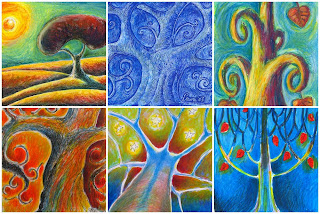
All artwork above © by Laura Medei
Laura Medei has developed a whimsical, dreamlike style with her paintings and sketches of trees (above) and her artwork never fails to delight and inspire me when I visit her Flickr album of sketches. If you enjoy her uplifting style as much as I do, why not check out the rest of her beautiful art?
| I recently found the book, The Night Life of Trees, on our public library shelf. Wow! Exquisite! Myth and poetry, vision and artistry combine to illustrate the deep connections many indigenous peoples have to all of Creation. These vivid tree portraits were created by Bhajju Shyam, Durga Bai and Ram Singh Urveti. Each volume is hand-screen printed and hand bound by Tara Publishing. The book is filled with intricately drawn visions of trees ... from the Gond tribe in central India, (who believe) trees stand in the middle of life and the spirit of many things lie in them. Trees are busy all day giving shade, shelter and food. Under the night skies, spirits of the trees are revealed. The Night Life of Trees is a tribute to the majesty of trees, and to old ways of relating to the natural world.Left:
| |
| | Ruby-Scented Dawn, by Catherine Hyde, an artist from UK. Hyde makes exceedingly beautiful christmas cards as well. Some of her tree images remind me vaguely of dreams, of Matisse, of childhood paintings made by smearing blackberry and chokecherry juice on concrete sidewalks ... |
| Robert Ryan, a paper-cut artist and illustrator, often depicts trees in his incredibly intricate paper-cuts and screen prints. Click here to see his papercut galleries or click on the images, left, for enlarged views. Below is a collaged photo of Robert's studio, originally posted on his blog, titled (ummm...) Robert Ryan. Another artist working in the paper-cut medium is Peter Callesen, who lives in Denmark. Though his medium is similar to that of Robert Ryan, Callesen's papercuts (left) are relatively simpler, though still incredibly elegant, and he often focuses on fairytales and constructs room-sized cut-paper installations as well. His website has so many beautiful pieces it was hard to choose just one to showcase here. |
Wednesday, August 29
Trees in Poetry & Prose
| Breath Tree, gather up my thoughts bring me together. Through your leaves breathe out the sky. - J. Daniel Beaudry © published in Nature in Legend and Story |
Trees are poems that earth writes upon the sky, We fell them down and turn them into paper, That we may record our emptiness. |
| Under the Walnut Tree |
| Alone with myself The trees bend to carress me The shade hugs my heart. - by Candy Polgar © Woods I part the out thrusting branches and come in beneath the blessed and the blessing trees. Though I am silent there is singing around me. Though I am dark there is vision around me. Though I am heavy there is flight around me. - Wendell Berry © from Collected Poems (North Point Press) |
| Fern-Leafed Beech This tree listened |
a few other links:
Solitary Trees
find other poets' work at Gratefulness.org
Trees in Myth and Legend
Spirit of Trees
Thursday, August 2
Top 4 US Fires in Montana

The wildfire burning just 10 miles from Helena, Montana blew up from 20,000+ acres on Tuesday to 31,000 acres by Wednesday. The fires in Montana and other states around the west are getting national coverage, though in my opinion, not enough is being said about how wildfire is an important part of the natural cycle and the fact that some of these fires are being "allowed" to burn is a perfectly reasonable way to manage the fires. If the fires were put out now, the threatened areas would eventually burn anyway -- and often will burn even more drastically becasue of the natural buildup of fuels.
The New York Times reported on Wednesday:
Firefighting crews in Montana battled the four top priority wildfires in the West on Wednesday, blazes that have led to the evacuation of hundreds of people.
In a normal year, Wednesday would have been the beginning of the summer fire season in Montana, but drought has put most of the state two to three weeks ahead of schedule and more hot, dry weather is forecast.
It's going to be a long season,'' said Warren Bielenberg, fire information officer for the Lewis and Clark National Forest in northwest Montana.
The No. 1 priority for firefighters Wednesday in the West was a blaze in the Gates of the Mountains Wilderness north of Helena that had blackened 31,238 acres, or about 49 square miles. Residents of 60 homes southeast of Wolf Creek were evacuated Tuesday, adding to residents of at least 60 other homes that were evacuated earlier.
The fire was moving north toward Holter Lake, a popular recreation area, and through a wildlife management area. It was about 25 percent contained but was expanding Wednesday toward evacuated areas to the southeast, where hand crews, aircraft and bulldozers worked to build lines and keep it in the wilderness ..."
To all who have written in concern for our safety in Helena, I just want to reassure you that we are fine -- the fire is 10 miles from the city and so far no one's home has burned. The firefighters are doing an outstanding job of protecting people's homes and animals. Still, your prayers are appreciated, here and all over the west where drought is making the 2007 fire season so much worse. Thank you! -- Maureen
Sunday, July 29
Plant a Tree
Do you want to plant a tree (or 2 or 3) yet
a.) keep putting it off until you settle down in one house for a long time?
b.) figure out exactly what you're going to do with your garden so you know exactly where to plant the tree?
c.) have enough money saved to afford a large tree?
d.) decide what kind of tree you want to plant?
e.) other?
The best time to plant a tree is twenty years ago. The second best time is now. -- International Society of Arborists
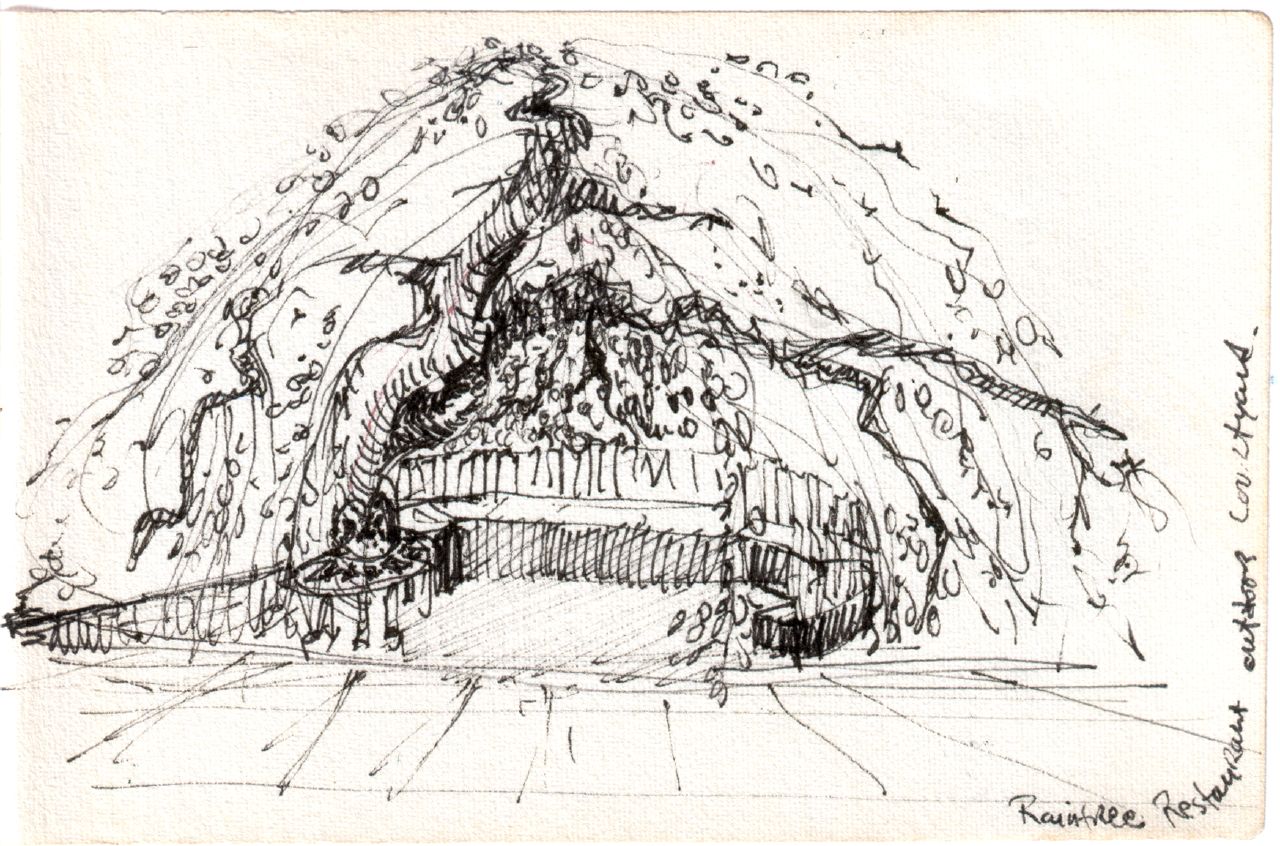
Weeping Tree over Bench, Copyright by Maureen Shaughnessy
HOW TO PLANT A TREE
So .... What are you Waiting For?
Click here for a fact sheet on planting a new tree.
a few facts about trees, listed on the International Society of Arborists website:
- In one year, an acre of trees can absorb as much carbon as is produced by a car driven up to 8700 miles.
- Trees provide shade and shelter, reducing yearly heating and cooling costs by 2.1 billion dollars.
- Trees lower air temperature by evaporating water in their leaves.
- The average tree in metropolitan area survives only about 8 years!
- A tree does not reach its most productive stage of carbon storage for about 10 years.
- Tree roots stabilize the soil and prevent erosion.
- Trees improve water quality by slowing and filtering rain water as well as protecting aquifers and watersheds.
- Trees provide food and shelter for wildlife.
- The death of one 70-year old tree would return over three tons of carbon to the atmosphere
If you love trees, and want to tell other people about it, please head over to the Festival of Trees coordinating blog to find out how to participate in the next festival. Click here:

I will be hosting Festival #15 for the month of September, at Raven's Nest
 (aka Water Earth Wind and Fire) ... so check back here around the 1st of September to see more about trees from all over the world.
(aka Water Earth Wind and Fire) ... so check back here around the 1st of September to see more about trees from all over the world.Saturday, July 28
Meriwether Fire Makes Its' Own Weather
I know that in many places all over the globe wildfires are burning places that are dry as a bone because of years and years of drought. Montana is one of those places. In some parts of the world, heavy rains after long drought have encouraged vast amounts of plant growth -- only creating more fuel for the fires to devour when the land does dry up again as it has in Montana. So, I know we are not alone in living with wildfire almost every summer. Though it is hard to breath some days, and the smoke makes our eyes sting, I feel grateful that our home is not threatened. And grateful to be alive. Never take our lives for granted!
Today this truly gigantic cloud formed over the Meriwether Fire in the mountains north of Helena. Thereis NO way I can capture the enormity of this cloud formation in a photograph. It towered over the city of Helena and over our valley. You can see the mountain ridgeline at the bottom left of this photo. This cloud was mostly smoke from the fire.
What's really incredible to me is that just yesterday, we couldn't see more than a few blocks in town and today, the air was much clearer, though just half hour after I shot this photo, the billowy "softness" had dispersed and the cloud was just an ordinary thick haze of hazardous smoke again.
Worth viewing Large on Black background
Friday, July 27
Montana Wildfire: too close for comfort
Here is what my town, Helena, Montana looked like yesterday at 1:35 pm. The smoke blew into town from the Meriwether Fire just north of town near the Gates of the Mountains Wilderness. The Forest Service's air quality level was the worst so far, with visibility at less than one mile. It was actually way less than one mile at the moment I shot this photo -- I couldn't even see across town just a few blocks away.
The Helena Cathedral's twin spires are barely visible in the center foreground. The mountain range on the north side of the valley are completed invisible. The fire is at the moment burning basically uncontrolled, though the Forest Service and other firefighting teams are trying to protect structures and homes in the path of the fire. Folks living in the area have been asked to evacuate. Some people do and others just want to stay home to protect their own homes and animals. I'd hate to have to make that decision!
Here is the same view of the Helena Valley last Winter, crystal clear air: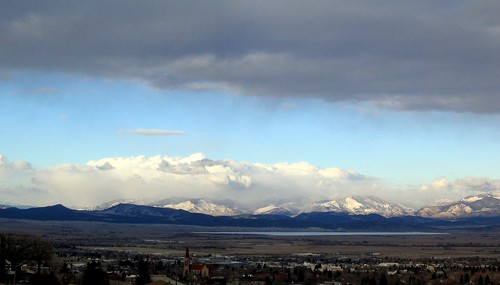
I shot a slightly different angle this April:
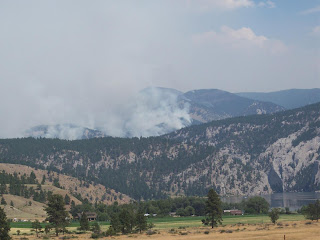
The above photo is on the Helena Independent Record Flashpoint page, a regularly updated page of information about the fires burning in and around Montana. Click the photo to go to the article about the fire, written by Martin Kidston.
Friday, July 20
Dr. Bronner's Magic Soap ... Box: a new film
Heard on NPRs weekend edition: Robert Smith interviewing Sara Lamm about her new film, Dr. Bronner's Magic Soapbox which opens in theatres in July. The documentary is about the man who invented the formula for the ubiquitous liquid soap, and whose main goal was to unite all of humankind by distributing the Moral ABC's printed in tiny letters on the soap labels.
Though the style of Emmanuel Bronner's message is a bit on the wacky side, it's always made for entertaining reading ... and when you really think about the essence of his message: that all religions are one and all people are one, it's hard to deny the truth of that -- and how appropriate that is for our world right now.
The film, Magic Soapbox follows Ralph Bronner, Emmanuel Bronner's 68 year old son, as he talks about the legacy his father left behind, and about growing up with a creative genius who was so obsessed with uniting all people on Earth, that he neglected his own family.
"My father was an eccentric -- he did not have a religion - he collected the best of all religions and philosophies put them on a soap label so people could see how much we have in common, and see each other as brothers and sisters, and you don't kill your brother and sister it would have put an end to war - it's as simple as that to put an end to war."
I've used Dr. Bronner's soap since 1972. My tastes in soap "flavors" have changed over the years, as new scents were introduced. It used to come in just peppermint. Now we can get lavender, eucalyptus, peppermint and tea tree soap. Since I buy it in bulk, I can mix the different scents. We use Dr. Bronner's for laundry, shampoo, body soap, hand soap and to dog-soap for Sam.
I love this description of the way the peppermint soap makes you tingle, written in a fan letter to Dr. Bronner's company:
"Dear Dr. Bronner, I want you to know how much I enjoy your peppermint soap. After I shower and dress it feels like someone put a york peppermint patty in my underwear."I wonder if Sam ever feels like he has a peppermint patty stuck in his fur after we give him a bath in Dr. B's???
Monday, July 16
Idyll for a Hot Summer Day
Our outdoor dining room is just a table and chairs under the lilac hedge. These lilacs are at least 50 years old, and I have trimmed and pruned them to create a "cave" or roof over that part of the garden. With the umbrella (barely visible above the table amongst the lilac branches) even when it rains in summer, we stay dry. At least until the wind starts blowing.
The hammock in the foreground is hanging between the house and the trunk of an 80+ year old Colorado Blue Spruce. The spruce is a condominium/apartment house for birds: chickadees, finches, pine siskins, magpies, ravens, flickers and the ever-present sparrows. In the mornings and evenings our garden is LOUD with birdsong .... and relaxing in the hammock in the evenings or late afternoons is like being in a concert hall -- or out on a school playground at recess. Joyful. Raucous. Busy.
Though it's not visible in this photo, between the hammock and the table in the background is our small garden pond with a trickling waterfall and a small splashing fountain. The birds love the water. So do I. Even when the birds are singing their little hearts out, this part of our garden has a real sense of peace because of the water, the shade, the privacy...
Our outdoor dining room is just a table and chairs under the lilac hedge. These lilacs are at least 50 years old, and I have trimmed and pruned them to create a "cave" or roof over that part of the garden. With the umbrella (barely visible above the table amongst the lilac branches) even when it rains in summer, we stay dry. At least until the wind starts blowing.
The hammock in the foreground is hanging between the house and the trunk of an 80+ year old Colorado Blue Spruce. The spruce is a condominium/apartment house for birds: chickadees, finches, pine siskins, magpies, ravens, flickers and the ever-present sparrows. In the mornings and evenings our garden is LOUD with birdsong .... and relaxing in the hammock in the evenings or late afternoons is like being in a concert hall -- or out on a school playground at recess. Joyful. Raucous. Busy.
Though it's not visible in this photo, between the hammock and the table in the background is our small garden pond with a trickling waterfall and a small splashing fountain. The birds love the water. So do I. Even when the birds are singing their little hearts out, this part of our garden has a real sense of peace because of the water, the shade, the privacy...
View On Black
Sunday, July 15
Morning Light
Shot a bunch of garden photos for a blog post on summer garden chores for these hot days of July.... This was one of the shots. I need to get out and deadhead my perennials -- daylilies open one bud each day -- and each bud lasts only one day. Each stalk of buds contains from 6 to 20 buds. Deadheading the spent lilies encourages the plants to set a few more buds.
Look for the dog-days-of-summer-garden-chores article in the next day or so.
Monday, June 18
Garden Lighting: Pre-Hailstorm-Sky-Color
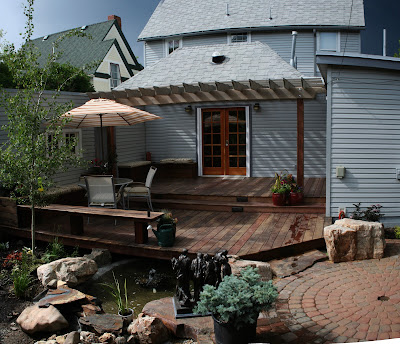
We are closing in on completing the Contemplative Garden. I am helping with the installation myself, which is different for me: getting muddy, wet, dirty, sweaty and so sore! But it's more fulfilling than ever because I have put my heart and soul into creating this tiny jewel-like garden. I almost don't want to finish! ;-)
Saturday I was watering and cleaning up over there, and thought I would shoot a few quick photos. I could tell we were in for a storm and the light -- the color of the sky -- was so beautiful! I was clicking away when a huge hail stone hit my camera body (fortunately not the lens) and before I could blink I was being pelted by hundreds of hard stones. Got in the car in a hurry!
Made me think of garden lighting. Here was a storm adding a whole new dimension of landscape lighting to this garden.
I always love the way the air seems to take on a thickness right before a big storm -- an actual color, rather than just a clearness. Hailstorms bring their own pre-storm color, the air tinged with a visceral yellow against dark blue-black clouds. Usually hailstorms hit us on early summer afternoons: sun close to the horizon slices through a hole in the clouds. That sunlight mixes with a palpable turbulence, an electric charge on the back of my neck, a yellowish caste in the air - it's enough of a warning for any soft-bodied creature to get under cover. And yet ...
And yet when hail stones threaten, that's when I most want to be out in the garden, taking it all in - it's as if the storm brings super-saturated colors to the ordinary landscape. It's exciting. A little dangerous. Sensual. Every color full of every possibility.
Right before a big storm I can clearly see -- and feel -- that color is made of light.
| www.flickr.com |
Above, more pix from this garden installation. Click on any of the photos to see a larger version, and from there, you can see the entire album. Enjoy!
Saturday, June 16
Mid-June Garden Delights
These photos were all taken on June 15 in our garden. The subjects are some of the more colorful parts of our garden at this time of the growing season.
Please enjoy the slideshow format. You can view any of these images enlarged as part of the Picasa album, by clicking in the lower left corner of the slideshow box, where it says: View Maureen's Album.
Wednesday, June 13
The whole wide world pours down
You will never be alone, you hear so deep
a sound when autumn comes...
... you never heard so deep a sound,
moss on rock, and years. You turn your head --
that's what the silence meant: you're not alone.
The whole wide world pours down.
-- Excerpt from Assurance by William Stafford
To everyone who has been asking about Sam, our 18-year old flatcoated retriever, I wanted to fill you in:
Sam is still going as strong as an old guy can ... he takes two walks each day. He beams at us, silently -- so perfectly communicating to us what he wants or needs, how much he loves, how he feels .... where he wants to be. He has slowed down markedly, yet I am still in awe of his age, his energy, his devotion, his enthusiasm for life.
I also wanted to share photo of Sam doing what he does best: dreaming, sleeping, wandering around in the forest of his heart ... in a state of silence (he is deaf now) and peaceful existence.
One day melts into another day, like a dream. I believe in his heart Sam remembers days when he could chase rabbits and almost catch them. Days when he could scout ahead of us on the trail -- far ahead -- and never have to pause to catch his breath or pretend to find a smell because he could not go on... days when he could leap effortlessly from a river bank, find the stick in cold deep water, and with perfect movement bring it back to shore
... memories like filtered sunlight falling all around him. The whole wide world pours down, like light, like leaves, like dreams, like love.
Friday, June 8
Portland 1st Thursday Art Update
 Gabe has posted an update and a bunch of photos (shot by Arian Stevens and others) of his one-man show during the First Thursday Art Walk in Portland.
Gabe has posted an update and a bunch of photos (shot by Arian Stevens and others) of his one-man show during the First Thursday Art Walk in Portland.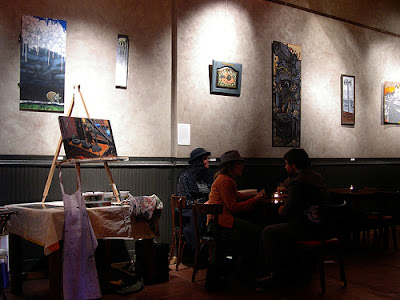
photos by Arian Stevens
Check out the live painting event at Berbati's with Gabe Shaughnessy painting his impressions of local d.j. Cool Hand Luke who spins his magic for club-goers and art-lookers alike. Sounds like the opening was a success. Here's an album with all his pics from the opening night.


